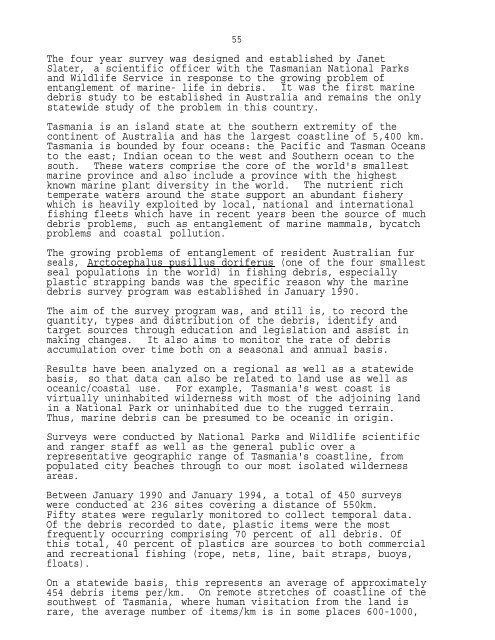Poster abstracts and manuscripts from the Third International ...
Poster abstracts and manuscripts from the Third International ...
Poster abstracts and manuscripts from the Third International ...
You also want an ePaper? Increase the reach of your titles
YUMPU automatically turns print PDFs into web optimized ePapers that Google loves.
55<br />
The four year survey was designed <strong>and</strong> established by Janet<br />
Slater, a scientific officer with <strong>the</strong> Tasmanian National Parks<br />
<strong>and</strong> Wildlife Service in response to <strong>the</strong> growing problem of<br />
entanglement of marine- life in debris. It was <strong>the</strong> first marine<br />
debris study to be established in Australia <strong>and</strong> remains <strong>the</strong> only<br />
statewide study of <strong>the</strong> problem in this country.<br />
Tasmania is an isl<strong>and</strong> state at <strong>the</strong> sou<strong>the</strong>rn extremity of <strong>the</strong><br />
continent of Australia <strong>and</strong> has <strong>the</strong> largest coastline of 5,400 km.<br />
Tasmania is bounded by four oceans: <strong>the</strong> Pacific <strong>and</strong> Tasman Oceans<br />
to <strong>the</strong> east; Indian ocean to <strong>the</strong> west <strong>and</strong> Sou<strong>the</strong>rn ocean to <strong>the</strong><br />
south. These waters comprise <strong>the</strong> core of <strong>the</strong> world's smallest<br />
marine province <strong>and</strong> also include a province with <strong>the</strong> highest<br />
known marine plant diversity in <strong>the</strong> world. The nutrient rich<br />
temperate waters around <strong>the</strong> state support an abundant fishery<br />
which is heavily exploited by local, national <strong>and</strong> international<br />
fishing fleets which have in recent years been <strong>the</strong> source of much<br />
debris problems, such as entanglement of marine mammals, bycatch<br />
problems <strong>and</strong> coastal pollution.<br />
The growing problems of entanglement of resident Australian fur<br />
seals, Arctocephalus pusillus doriferus (one of <strong>the</strong> four smallest<br />
seal populations in <strong>the</strong> world) in fishing debris, especially<br />
plastic strapping b<strong>and</strong>s was <strong>the</strong> specific reason why <strong>the</strong> marine<br />
debris survey program was established in January 1990.<br />
The aim of <strong>the</strong> survey program was, <strong>and</strong> still is, to record <strong>the</strong><br />
quantity, types <strong>and</strong> distribution of <strong>the</strong> debris, identify <strong>and</strong><br />
target sources through education <strong>and</strong> legislation <strong>and</strong> assist in<br />
making changes. It also aims to monitor <strong>the</strong> rate of debris<br />
accumulation over time both on a seasonal <strong>and</strong> annual basis.<br />
Results have been analyzed on a regional as well as a statewide<br />
basis, so that data can also be related to l<strong>and</strong> use as well as<br />
oceanic/coastal use. For example, Tasmania's west coast is<br />
virtually uninhabited wilderness with most of <strong>the</strong> adjoining l<strong>and</strong><br />
in a National Park or uninhabited due to <strong>the</strong> rugged terrain.<br />
Thus, marine debris can be presumed to be oceanic in origin.<br />
Surveys were conducted by National Parks <strong>and</strong> Wildlife scientific<br />
<strong>and</strong> ranger staff as well as <strong>the</strong> general public over a<br />
representative geographic range of Tasmania's coastline, <strong>from</strong><br />
populated city beaches through to our most isolated wilderness<br />
areas.<br />
Between January 1990 <strong>and</strong> January 1994, a total of 450 surveys<br />
were conducted at 236 sites covering a distance of 550km.<br />
Fifty states were regularly monitored to collect temporal data.<br />
Of <strong>the</strong> debris recorded to date, plastic items were <strong>the</strong> most<br />
frequently occurring comprising 70 percent of all debris. Of<br />
this total, 40 percent of plastics are sources to both commercial<br />
<strong>and</strong> recreational fishing (rope, nets, line, bait straps, buoys,<br />
floats).<br />
On a statewide basis, this represents an average of approximately<br />
454 debris items per/km. On remote stretches of coastline of <strong>the</strong><br />
southwest of Tasmania, where human visitation <strong>from</strong> <strong>the</strong> l<strong>and</strong> is<br />
rare, <strong>the</strong> average number of items/km is in some places 600-1000,
















